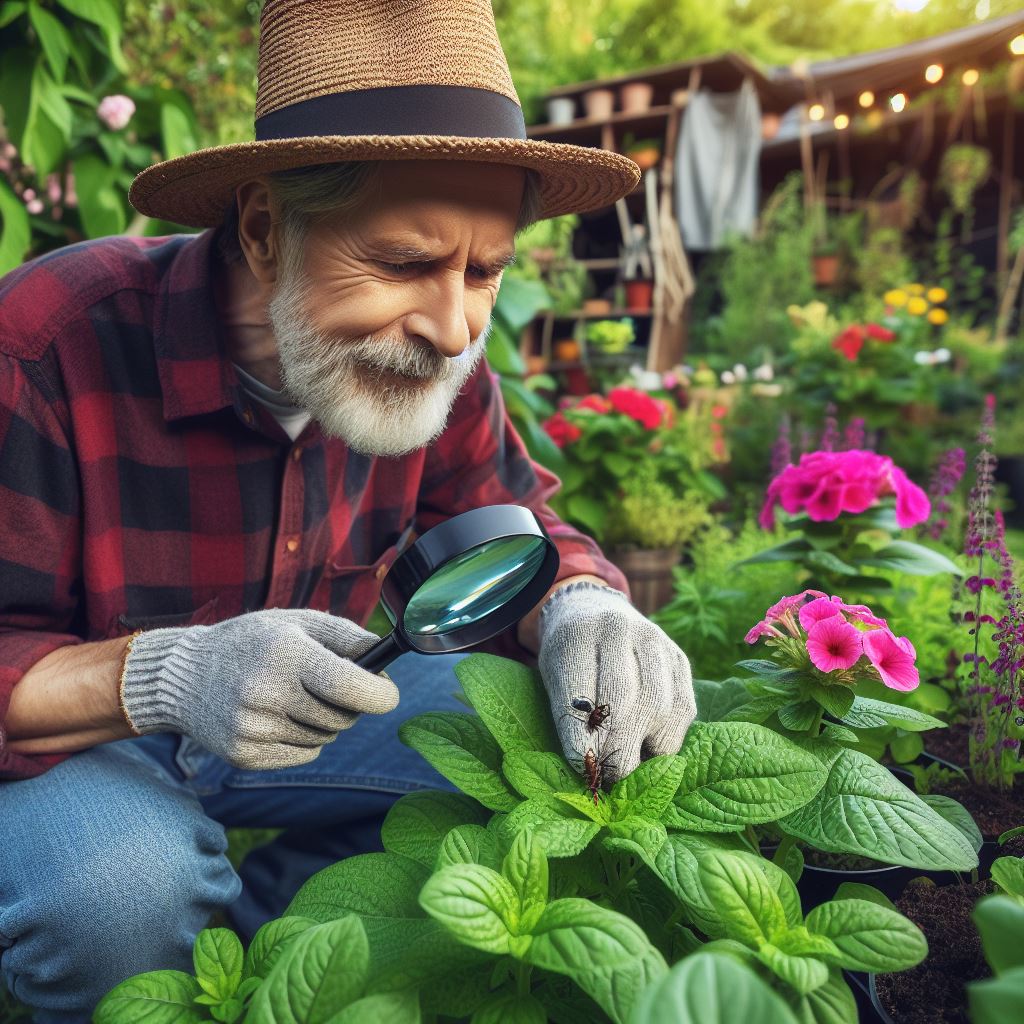Introduction
Organic gardening is a holistic approach to growing plants, focusing on natural methods and avoiding harmful chemicals.
In this blog post, we will discuss the importance of pest identification in organic gardening.
Overview of organic gardening
Organic gardening promotes a sustainable ecosystem using compost, natural fertilizers, and companion planting.
Importance of pest identification in organic gardening
Identifying garden pests is crucial in organic gardening as it helps determine the right pest control methods.
Pest identification allows gardeners to understand the specific pests they are dealing with, their life cycles, and habits.
This knowledge aids in implementing effective and targeted solutions that minimize harm to beneficial insects.
Different pests attack various plants in unique ways.
Identifying them helps in early detection and prevention of severe damage.
Physical inspection of plants can reveal visible signs of pest infestation, such as chewed leaves, holes, or eggs.
This enables gardeners to take immediate action.
Identifying beneficial insects is equally important.
These insects help control pests naturally, reducing the need for pesticides.
Proper identification helps avoid misdiagnosis, preventing unnecessary treatment that may harm the ecosystem.
Several identification methods can be used, including visual observation, trapping, and monitoring.
These methods assist in determining the type and severity of pest infestation.
Transform Your Agribusiness
Unlock your farm's potential with expert advice tailored to your needs. Get actionable steps that drive real results.
Get StartedOnline resources, field guides, and local extension offices are valuable sources for identifying garden pests.
Basically, accurate pest identification is essential in organic gardening.
It enables gardeners to choose the right control methods that are effective, environmentally friendly, and preserve the natural balance of the garden ecosystem.
Read: Container Gardening: Organic Options
Common Garden Pests and Their Identification
Aphids
- Physical description: Small, soft-bodied insects ranging in color from green to brown.
- Signs of infestation: Curling leaves, sticky residue called honeydew, presence of ants.
- Damage caused: Stunted growth, distorted leaves, transmission of plant diseases.
- Prevention and control measures: Regularly inspect plants, use insecticidal soap or natural predators like ladybugs.
Slugs and Snails
- Physical description: Slime-covered creatures, Slugs have no external shell while snails have shells.
- Signs of infestation: Irregular holes in leaves, silver trails, plants with ragged edges.
- Damage caused: Destruction of foliage, fruits, and flowers.
- Prevention and control measures: Remove hiding places, set up traps, use barriers like crushed eggshells or copper tape.
Caterpillars
- Physical description: Larval stage of moths or butterflies, segmented bodies with varying colors.
- Signs of infestation: Chewed leaves, presence of droppings or frass, silk webs.
- Damage caused: Defoliation, holes in leaves, fruit or flower damage.
- Prevention and control measures: Handpick caterpillars, use predatory insects, apply organic insecticides.
Beetles
- Physical description: Hard-shelled insects, come in various sizes, shapes, and colors.
- Signs of infestation: Holes in leaves, flowers, or fruits, skeletonized foliage.
- Damage caused: Defoliation, reduced vigor, transmission of plant diseases.
- Prevention and control measures: Handpick beetles, use insecticidal soap, employ row covers.
Spider Mites
- Physical description: Tiny, eight-legged arachnids, reddish or yellowish in color.
- Signs of infestation: Fine webbing, stippled or discolored leaves, reduced plant vitality.
- Damage caused: Yellowing leaves, leaf drop, reduced plant growth.
- Prevention and control measures: Increase humidity, spray plants with water, apply insecticidal soap.
Garden pests can wreak havoc on our organic gardens, damaging plants and frustrating gardeners.
Understanding the identification and characteristics of these pests is crucial for effective management and control.
By identifying common garden pests, we can take proactive measures to prevent and minimize their impact on our precious plants.
Aphids
Aphids are small, soft-bodied insects that come in various colors. They can be green, brown, or even black.
Signs of aphid infestation include curled leaves and the presence of sticky residue called honeydew.
Furthermore, ants may also be present as they are attracted to the honeydew.
The damage caused by aphids includes stunted growth, distorted leaves, and potential transmission of plant diseases.
To prevent and control aphids, regular inspection of plants is recommended.
Using insecticidal soap or introducing natural predators like ladybugs can also help keep aphid populations in check.
Slugs and snails
These are slimy creatures that can cause significant damage to garden plants.
Slugs have no external shell, while snails have a protective shell.
The signs of their presence include irregular holes in leaves, silver trails, and plants with ragged edges.
These pests can destroy foliage, fruits, and flowers.
To prevent slugs and snails from infesting your garden, it is important to remove their hiding places, such as leaf piles or debris.
Setting up traps and using barriers like crushed eggshells or copper tape can also deter these pests.
Caterpillars
Caterpillars are the larval stage of moths or butterflies.
They have segmented bodies and come in various colors.
Signs of caterpillar infestation include chewed leaves, presence of droppings or frass, and silk webs.
These pests can cause defoliation, leaving behind holes in leaves or damaging fruits and flowers.
To control caterpillars, handpicking them off plants is an effective method, especially for small infestations.
Showcase Your Farming Business
Publish your professional farming services profile on our blog for a one-time fee of $200 and reach a dedicated audience of farmers and agribusiness owners.
Publish Your ProfileIntroducing predatory insects or applying organic insecticides can also help manage their populations.
Beetles
Beetles are hard-shelled insects that come in different shapes, sizes, and colors.
They can be responsible for causing holes in leaves, flowers, or fruits, and may even skeletonize foliage.
The damage caused by beetles includes defoliation, reduced plant vigor, and potential transmission of plant diseases.
To prevent and control beetles, handpicking them off plants, using insecticidal soap, or employing row covers can be effective strategies.
Spider mites
Spider mites are tiny arachnids with eight legs.
They come in reddish or yellowish colors.
Signs of spider mite infestation include the presence of fine webbing, stippled or discolored leaves, and reduced plant vitality.
These pests can cause yellowing leaves, leaf drop, and hindered plant growth.
Increasing humidity, regularly spraying plants with water, and applying insecticidal soap are all recommended measures for prevention and control of spidermites.
By familiarizing ourselves with the physical characteristics, signs of infestation, damage caused, and prevention and control measures for these common garden pests, we can actively protect our organic gardens and ensure the health and productivity of our plants.
Implementing organic and sustainable pest management techniques allows us to minimize the use of harmful chemicals and create a balanced ecosystem within our gardens.
Remember to monitor your plants regularly and take swift action when pests are detected to maintain a thriving organic garden.
Read: Hydroponic Hacks: Low-Cost Setup Ideas
Beneficial Insects
Ladybugs
- Physical description: Ladybugs are small insects with round bodies and colorful spots.
- Benefits for organic gardens: Ladybugs are natural predators of many garden pests.
- Attracting and maintaining ladybugs: Planting flowers like daisies and marigolds can attract them.
- Importance in pest control: Ladybugs eat aphids, mites, and other damaging insects in the garden.
Lacewings
- Physical description: Lacewings have delicate green or brown wings and long antennae.
- Benefits for organic gardens: Lacewings feed on pests like aphids, caterpillars, and mealybugs.
- Attracting and maintaining lacewings: Provide diverse habitats with flowering plants and water sources.
- Importance in pest control: Lacewings consume a large number of garden pests, reducing their population.
Hoverflies
- Physical description: Hoverflies resemble bees or wasps and have yellow and black stripes.
- Benefits for organic gardens: Hoverflies prey on aphids, thrips, and other plant-damaging insects.
- Attracting and maintaining hoverflies: Planting nectar-rich flowers like lavender and chamomile can attract them.
- Importance in pest control: Hoverflies help control pest populations and pollinate flowers in the garden.
Parasitic wasps
- Physical description: Parasitic wasps are small, slender insects with long antennae.
- Benefits for organic gardens: They parasitize and kill pests like caterpillars, aphids, and whiteflies.
- Attracting and maintaining parasitic wasps: Planting diverse flowering plants can attract them to the garden.
- Importance in pest control: Parasitic wasps play a crucial role in reducing pest populations naturally.
Beneficial insects are the unsung heroes of organic pest control in gardens.
These tiny creatures play a vital role in maintaining a balanced ecosystem, keeping harmful pests in check, and preserving the health and productivity of plants.
Ladybugs
Ladybugs, also known as ladybirds or lady beetles, are some of the most recognizable and well-known beneficial insects.
They have a unique physical appearance with their round bodies and bright spots.
In organic gardens, ladybugs are valuable allies as they feed on pests like aphids, scale insects, and mites.
These voracious predators can consume hundreds of aphids per day, providing natural pest control without the need for harmful chemicals.
Attracting and maintaining ladybugs in the garden is relatively easy.
Planting flowers like daisies, marigolds, and yarrow can attract ladybugs by providing pollen and nectar.
Ladybugs also require a water source, so providing shallow dishes filled with water can attract and retain these helpful insects.
By creating an inviting habitat, gardeners can ensure a healthy population of ladybugs, contributing to a more pest-resistant garden.
Lacewings
Lacewings are another group of beneficial insects that aid in organic pest control.
These delicate insects have distinctive green or brown wings and are great predators of aphids, caterpillars, and mealybugs.
By releasing lacewing eggs or attracting adult lacewings with flowers like alyssum or cosmos, gardeners can naturally control pest populations and reduce the need for chemical interventions.
Hoverflies
Hoverflies, often mistaken for bees or wasps due to their yellow and black stripes, are significant allies in organic gardens.
These harmless flies feed on plant-damaging insects such as aphids, thrips, and leafhoppers.
To attract hoverflies, gardeners can plant nectar-rich flowers like lavender, chamomile, and sunflowers.
The presence of hoverflies not only helps control pests but also contributes to pollination, ensuring the health and reproduction of flowering plants.
Parasitic wasps
Parasitic wasps may sound intimidating, but they are actually harmless to humans and beneficial for gardens.
These small, slender insects lay their eggs inside or on pests like caterpillars, aphids, and whiteflies.
As the parasitic wasp larvae develop, they consume the host from the inside, eventually killing it.
To attract parasitic wasps, it is essential to plant diverse flowering plants that provide them with nectar and pollen.
By attracting these beneficial insects, gardeners can effectively control pest populations and maintain a healthy garden ecosystem.
In general, beneficial insects are indispensable allies in organic gardening, promoting sustainable and eco-friendly pest control methods.
Ladybugs, lacewings, hoverflies, and parasitic wasps are just a few examples of these helpful insects.
By understanding their physical characteristics, benefits, and how to attract and maintain them in the garden, gardeners can harness the power of nature to combat garden pests and create a thriving organic garden.
Read: Small Space, Big Yield: Hydroponic Tips
Showcase Your Farming Business
Publish your professional farming services profile on our blog for a one-time fee of $200 and reach a dedicated audience of farmers and agribusiness owners.
Publish Your Profile
Organic pest control methods
Companion Planting
- Beneficial plant combinations such as marigolds and tomatoes or basil and peppers can deter pests.
- In addition to pest control, companion planting can enhance pollination and maximize garden space.
- Ensure successful companion planting by selecting plants with similar sun, soil, and watering needs.
Organic Sprays and Solutions
- Neem oil is a natural insect repellent that can be used to control various pests on plants.
- Soap spray made from a mixture of water and mild liquid soap can suffocate and kill soft-bodied insects.
- Garlic and chili spray can repel pests with their strong odor and taste.
- Explore homemade recipes for organic sprays using ingredients like vinegar, baking soda, and essential oils.
Crop Rotation
- Crop rotation involves systematically changing the location of crops in the garden from season to season.
- By rotating crops, you can disrupt the life cycle of pests, lower their population, and reduce disease risk.
- Develop a rotation schedule considering the families of plants and factors like soil fertility and pest vulnerability.
Physical Barriers and Traps
- Row covers made of lightweight fabric can protect plants from pests while allowing air, sunlight, and water to reach them.
- Netting can keep birds, insects, and larger pests like rabbits away from vulnerable plants.
- Sticky traps coated with adhesive can capture flying insects and help monitor pest populations.
- Get creative with homemade traps like beer traps for slugs or yellow sticky cards for aphids.
Companion Planting
Implementing organic pest control methods in your garden not only promotes a healthy ecosystem but also reduces the need for harmful chemicals.
Companion planting is a popular approach that involves planting certain crops together to repel pests naturally.
For example, marigolds emit a scent that deters pests, making them ideal companions for tomatoes.
Similarly, basil planted near peppers can help repel aphids and other insects.
Aside from pest control, companion planting offers additional benefits.
Some plants attract beneficial insects like bees and ladybugs, which help pollinate flowers and prey on harmful pests.
Additionally, certain combinations can optimize space utilization.
For example, tall plants like corn can provide shade for smaller plants, conserving moisture and preventing weed growth.
To succeed with companion planting, it’s important to consider compatibility in terms of sunlight, soil, and water requirements.
Ensure that the companion plants have similar needs to avoid competition and optimize their benefits.
Research the optimal spacing and planting techniques for each combination to maximize their effectiveness.
Organic Sprays and Solutions
Organic sprays and solutions offer another effective method for controlling pests in an environment-friendly way.
Neem oil, derived from the neem tree, has insecticidal properties and can be diluted in water to create a spray.
This natural repellent is effective against a wide range of pests without harming beneficial insects.
Soap spray made from a mixture of water and mild liquid soap is another organic option.
When sprayed on pests, the soapy solution suffocates and ultimately kills them.
It is particularly useful against soft-bodied insects like aphids, spider mites, and whiteflies.
If you prefer a homemade approach, garlic and chili spray can be effective.
The pungent odor and spicy taste repel pests, making them less likely to feed on your plants.
To make this spray, combine crushed garlic cloves and chili peppers with water in a blender, strain the mixture, and use it as a deterrent.
Crop Rotation
Crop rotation is a preventive measure that disrupts the life cycles of pests and reduces the risk of diseases.
The concept revolves around moving plants from one area to another in the garden, ensuring that plants from the same family are not grown in the same location year after year.
This practice helps to avoid a buildup of pests and diseases specific to certain plant families.
Crop rotation offers multiple benefits in pest prevention.
By changing the planting locations, pests that overwinter or lay eggs in the soil are less likely to find their preferred host plants.
Furthermore, different crops have varying nutritional needs, so rotating crops can help balance soil fertility and reduce the risk of nutrient deficiencies or excesses.
When planning a crop rotation schedule, consider factors like the duration of different crops, their nutrient requirements, and susceptibility to specific pests.
This information will help create an effective rotation plan that maximizes pest control and maintains soil health.
Physical Barriers and Traps
Physical barriers and traps provide additional means of organic pest control.
Row covers
Row covers made of lightweight fabric can shield plants from pests while still allowing essential light, air, and water to reach them.
These covers are particularly useful in protecting plants from flying insects like leaf beetles and cabbage moths.
Netting
Netting is another physical barrier that can effectively keep birds, insects, and larger pests like rabbits away from vulnerable plants.
This barrier is commonly used on fruit trees and bushes to prevent birds from eating the fruits or laying eggs on the plants.
Sticky traps
Sticky traps are adhesive-coated surfaces that attract and capture flying insects.
They can be purchased or easily made at home using bright yellow or blue cardboard or plastic sheets.
Hang these traps near your plants to monitor pest populations and reduce their numbers.
By incorporating these organic pest control methods into your gardening practices, you can protect your plants from harmful pests while minimizing the use of chemical pesticides.
Embrace the power of companion planting, explore natural sprays and solutions, adopt crop rotation strategies, and utilize physical barriers and traps to maintain a healthy and bountiful garden.
Read: Harvesting & Preserving Your Organic Produce
Conclusion
Recap of important points
It is essential to recap the important points discussed in this guide.
Showcase Your Farming Business
Publish your professional farming services profile on our blog for a one-time fee of $200 and reach a dedicated audience of farmers and agribusiness owners.
Publish Your ProfileOrganic pest control is a natural and eco-friendly way to manage pests in your garden.
By using the organic garden pest identification guide, you can easily identify and target specific pests without harming beneficial insects or the environment.
Encouragement to use organic pest identification guide for successful gardening
The guide provides valuable information on various pests and their identification, enabling you to take appropriate measures to eliminate them.
This ensures that you can maintain a healthy garden without relying on harmful chemical pesticides.
Overall benefits of organic pest control in gardens
Furthermore, organic pest control offers several benefits for your garden.
Firstly, it promotes biodiversity by preserving the natural balance of beneficial insects and pests.
This creates a sustainable ecosystem where pests are kept under control without completely eliminating them.
Moreover, organic pest control reduces the risk of chemical exposure to both humans and pets.
Chemical pesticides can have harmful effects on health and the environment.
By using organic methods, you can avoid these risks and create a safe gardening environment.
In a nutshell, the organic garden pest identification guide is an excellent resource for successful gardening.
It empowers you to identify pests accurately and choose appropriate control methods that align with eco-friendly practices.
By implementing organic pest control, you can enjoy a bountiful and thriving garden while protecting the environment.




